Dinosaur Tracks and Other Trace Fossils on Display
After reporting on fossil thefts, vandalism and other sad incidents from the Moab area (Utah), it is a pleasure to write about the opening this month of a new dinosaur track and trace fossil trail. In a short presentation, Bureau of Land Management personnel hosted the opening ceremony for the new trace fossil site, one that preserves life on an algae covered mudflat some 112 million years ago or thereabouts. The new tourist attraction, named the Mill Canyon Dinosaur Tracksite Trail, features more than two hundred individual dinosaur prints, representing eight different types of tracks and some six different types of dinosaur.
Some of the Prehistoric Animal Tracks on the Trail
Picture credit: Bureau of Land Management
Fossil Thefts and Vandalism
Sadly, over the years this blog has reported on the destruction of a number of the fossils found in this part of Grand County, eastern Utah. For example, last year Everything Dinosaur reported on an aborted attempt to make copies of three-toed dinosaur tracks in the Moab area, this resulted in extensive damage to these rare dinosaur fossils: Dinosaur Tracks Vandalised, worse still, was the case of a dinosaur footprint theft from the Hell’s Trail location near to Moab, this print (another three-toed, tridactyl footprint) was never recovered, although an arrest was made and local Moab resident Jared Ehlers was sentenced to six months house arrest and one year of probation with a $15,000 USD fine.
To read the story of the dinosaur fossil footprint theft: Dinosaur Fossil Footprint Stolen
The Mudflats Preserve the Footprints and Trace Fossils from a Number of Prehistoric Animals Including Armoured Dinosaurs
Picture credit: Brain Engh
A Unique Insight into Early Cretaceous North America
The strata forms part of the Ruby Ranch Member of the Cedar Mountain Formation, the mudstones were laid down in an inland floodplain environment with seasonal extremes of wet and dry. A film of algae formed over the mudflats and it is thanks to this algal mat that the fine details of the trace fossils have been preserved. Individual claw marks can be made out and there are other remarkable trace fossils too, such as the gashes in the mudstone, evidence of an ancient crocodile’s tail drag.
Ancient Crocodiles Thrived in this Lacustrine (Lake) Environment
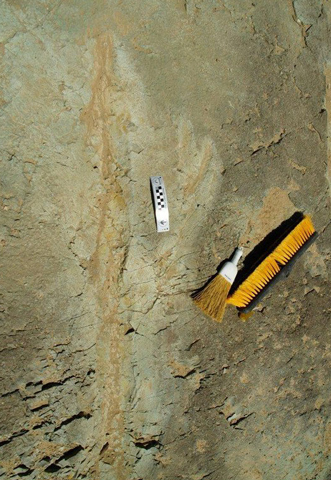
The tail drag made by an ancient crocodile preserved in the Ruby Ranch mudstones of the Cedar Mountain Formation (Utah).
Picture credit: Bureau of Land Management
In the picture above the brushes and scale marker provide a visual guide to the size of the crocodile tail drag.
Commenting on the importance of the site and the vital role that the algae played in fossil preservation, Bureau of Land Management palaeontologist Rebecca Hunt-Foster stated:
“The algal mat that covered the mud helped to preserve the detail of the tracks when a finer-grained sediment washed over the mudflat. This preserved the imprints in great detail, the algal covering helped to keep the finer details of the tracks, such as the impact rims made when the animals stepped into the soft mud, along with foot pad impressions, from being eroded away or damaged during this covering event.”
2009 Discovery
The site was discovered in 2009, when a local person travelling over the area in a jeep noticed strange impressions on the ground. Since 2013, a team of palaeontologists have been recording and mapping the location and thanks to funding from the Canyonlands Natural History Association, private donations and a contribution from the Bureau of Land Management itself, a tourist trail with dedicated walkways and helpful information boards has been established.
Dinosaur tracks include the large three-toed prints of a substantial theropod, rounded tracks of a sauropod, plus the tell-tale two-toed tracks of a big dromaeosaur, something akin to a Utahraptor (U. ostrummaysorum) fossils of which are found in the older Yellow Cat Member of the Cedar Mountain Formation.
Visitors to the Site Can Use Walkways to Get Close to the Fossils
Picture credit: Bureau of Land Management
Dinosaur Track
The site is particularly important as it preserves activity (trace fossils) and very few body fossils of large vertebrates have been found in the Ruby Ranch Member, when compared to other parts of the Cedar Mountain Formation. The trace fossils provide a guide to the dinosaur fauna that inhabited this part of the world during the latter stages of the Early Cretaceous.
Which Armoured Dinosaur(s)?
Intriguingly, the site preserves the tracks of an armoured dinosaur. The rounded, five-toed prints are quite distinct and form parallel lines in the mudstone, where the slow moving, plodding dinosaur passed by. Palaeontologists are not sure what type of armoured dinosaur made the prints, the strata is too old for it to represent the tracks made by a Sauropelta and although fossils of the polacanthid Gastonia have been found in Grand County, Utah, most of the fossil material ascribed to the only species assigned to the Gastonia genus (G. burgei) are associated with the older Yellow Cat Member. The tracks could have been made by, an as yet, unnamed species of Gastonia or perhaps a different type of polacanthid altogether.
An Illustration of Gastonia (G. burgei)
Picture credit: Everything Dinosaur
For models and replicas of armoured dinosuars and other prehistoric animals: CollectA Age of Dinosaurs Popular Figures.
A spokesperson from Everything Dinosaur commented:
“It is wonderful to be able to report on some positive news from Grand County, we wish the site’s management team every success and we hope that this remarkable window into the Early Cretaceous attracts lots of visitors and helps to preserve the amazing fossils to be found in this part of the western United States.”


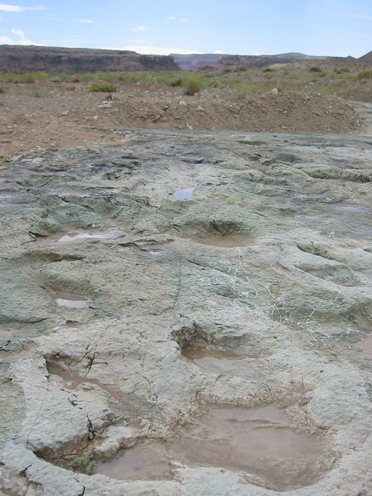
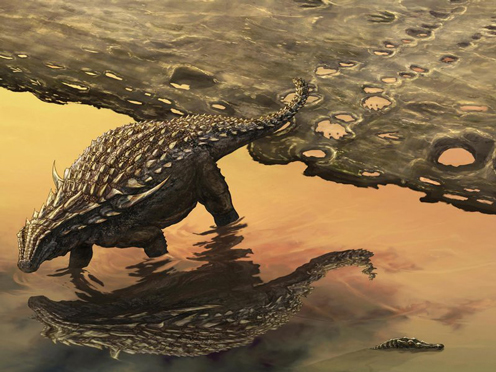
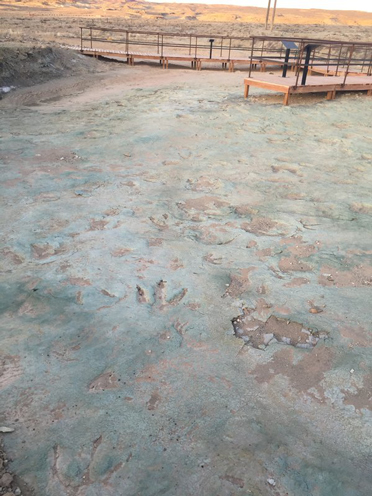
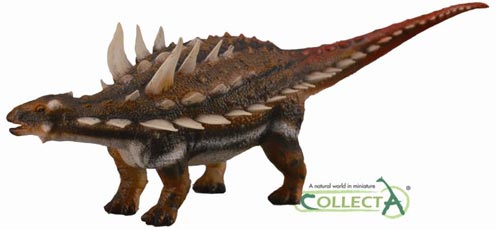




Leave A Comment